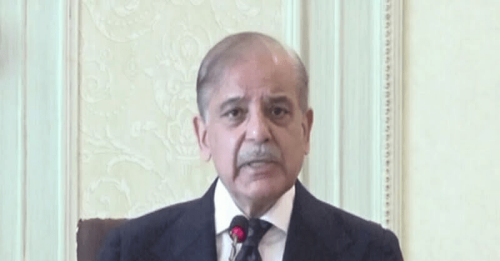In the exhibition ‘Hungry Shores’ that opened on April 16 at Canvas Gallery in Karachi, artist Zulfikar Ali Bhutto embarks on a profound exploration of the cultural, historical and human landscape woven along the banks of the Indus River in Sindh, viewing it through the unique perspective of the blind Indus River dolphin. Teaming up with fellow artist Saba Khan, Bhutto unveils a compelling narrative that delves into the delicate balance between human interaction and environmental stewardship.
Following an extensive expedition around the Guddu and Sukkur Barrages, Bhutto and Khan immersed themselves in the habitat of the iconic blind Indus River dolphin, known as bulhan by the locals. Khan’s contribution to the exhibit manifests in four large oil-on-canvas pieces, employing the metaphor of the dolphin’s gradual loss of sight to illustrate humanity’s blind exploitation of nature, particularly through the extraction of aquifers and the mechanisation of water for utilitarian purposes. This concept is powerfully resonant in her artwork Covers.
Meanwhile, Bhutto’s contribution, part of his ongoing series Bulhan Nameh [Dolphin Diaries], captivates viewers with its hauntingly beautiful cyanotypes. Utilising one of the oldest photographic printing techniques, his cyanotypes exude a mesmerising cyan blue hue, evoking a sense of timelessness.
Through these exquisite works, Bhutto invites audiences to contemplate how we perceive and interact with the rich tapestry of the Indus River landscape, offering a poignant glimpse into the world as experienced by the blind dolphin.
Zulfikar Ali Bhutto and Saba Khan explore the human, ecological and social landscape of the River Indus through the eyes of the river’s endangered blind dolphins
In her statement, Khan, who was not in Pakistan at the time of this exhibition, writes, “This river species evolved over millions of years to adapt to the muddy waters of Indus, letting go of its eyes and relying on sonar for communication. Indus is a dark river, because ‘young’ Karakorum Mountains continue to erode and silt the rivers. In geological time, the dolphins are as old as the nearby coal mines in Thar.”

With a Bachelor of Fine Arts in 2005 from the National College of Arts, Lahore, and a Masters of Fine Arts (MFA) from Boston University, America in 2010, Khan has had two recent shows at Canvas Gallery: Water Explorer (2021), and Toxic Waters (2023). In 2019, she founded a satirical artist collective of women artists who lead expeditions, called the Pak Khawateen Painting Club.
Bhutto earned his Masters in History of Art from the University of Edinburgh in 2014, followed by an MFA from the San Francisco Art Institute in 2016. He has exhibited his work and curated exhibitions on a global scale, and has been invited to speak at esteemed institutions such as Columbia University, UC Berkeley, New York University and Stanford.
With ‘Hungry Shores,’ Bhutto and Khan beckon viewers to reconsider their relationship with nature, urging them to recognise the interconnectedness of human existence and the delicate ecosystems that sustain us.

The focal area of this research is the city of Sukkur, where shrines, temples, forts, iconic bridges and massive irrigation projects crowd a less than 10-kilometre stretch of river that is also home to one of the highest concentrations of dolphins in Pakistan. The enigmatic denizen of the ancient river is among the planet’s most imperilled cetaceans. The Indus, a majestic transboundary river originating in the Himalayas, symbolises both vitality and vulnerability, having been the epicentre of the catastrophic floods that ravaged Pakistan in 2022.
Bhutto’s artworks, such as Zinda Pir’s Bhulan and Zinda Pir’s Fracture 2, delve into Khwaja Khizr, a mysterious figure revered across religions. His island shrine once hosted both a temple and mosque, which are now separated. The pieces also examine Khizr’s connection with the blind Indus River dolphin. Known as the ever-living saint, he’s associated with Surah Kahf of the Quran, and is said to dwell eternally in the rivers and seas.

Through critical examinations of oceanic ecosystems and our intricate connections with marine life, Bhutto illuminates the concept of “weathering”, inviting us to reconceptualise our bodies as repositories of climate history and as architects of future environmental dynamics — bridging the gap between the distant ice caps and the intimacy of our own skin. Ecological phenomena, he suggests, are not mere occurrences around us, but are intertwined within us, shaping us and shaped by us.
The ritual of “weathering” unfolds across multiple stages in Bhutto’s artistic process, each imbued with profound significance. From his immersive journeys into the river to gather materials, to the meticulous pinhole photography capturing fleeting moments of light, to the sun-drenched rooftops where his prints are exposed, and finally to the cleansing waters where the fabrics are purified — each step is a fusion of global exploration and deep-rooted local connection.
Through his art, Bhutto beckons us to rediscover the sacred essence of our natural world and to forge a renewed relationship with the rivers that pulse through our collective consciousness.
‘Hungry Shores’ was on display at Canvas Gallery in Karachi from April 16-25, 2024
Rumana Husain is a writer, artist and educator. She is the author of two coffee-table books on Karachi, and has authored and illustrated 75 children’s books
Published in Dawn, EOS, May 5th, 2024
















































Dear visitor, the comments section is undergoing an overhaul and will return soon.